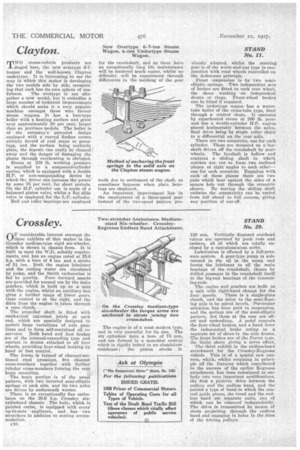Crossley.
Page 142

If you've noticed an error in this article please click here to report it so we can fix it.
OF considerable interest amongst the three exhibits of this • maker is the Crossley medium-type rigid six-wheeler, which is shown in chassis form.. It is built to meet the W.D. subsidy requirements, and has an engine rated at 25.6 h.p. with a bore of 4 ins, and a stroke of 51 ins. Beth the engine lubricant and the cooling water are circulated by pump, and the Smith carburetter is fedby gravity. Pour forward speeds are provided for normal use by the Wain gearbox, which is built up as a unit with the engine, whilst an auxiliary box gives a further range of lower gears. Gear control is at the right, and the drive fromthe engine is taken through a cone clutch.
The propeller shaft is fitted with mechanical universal jointsat each end, which are specially designed to permit .large variations of axle positions and to form self-contained oil
Icsorvoirs, Both hand and foot brakes are of the internal-expanding type and operate in drums attached to all four wheels, providing four-wheel braking by hand or foot control.
The frame is formed of channel-sectioned steel pressings, five channel cross-members together with further tubular cross-members forming the rear bogie mounting.
The bogie portion is a the• usual pattern, with two inverted semi-elliptic springs at each side, and its two axles are driven by underneath worms.
There is an exceptionally fine ambulance on the 20.9 hp. Crossley sixcylindered chassis. The body, which is painted cerise, is equipped with every up-to-date • appliance, and has two stretchers in addition to seating accommodation.
F16 • The engine is of a most modern type, and is very powerful for its size. The six cylinders have a bore of 75 mm. and are formed in a monobloc casting which is rigidly bolted to an. aluminium , crankcase; the piston stroke is
120 mum. Vertically disposed overhead valves are operated by push rods and rockers, all Of which are totally enclosed by a cast-aluminium co-ter.
-Lubrication is effected by a full-pressure system. A gear-type pump is submerged in the oil in the sump and farces the lubricant to all the main bearings of the crankshaft, thence by drilled passages in the crankshaft itself to the big-end bearings of the connecting-rods.
The engine and gearbox are built as a unit with _right-hand change for the four speeds. There is a single-plate clutch, and the drive to the semi-floating axle is by spiral bevels. Particular attention has -been paid to suspension, and the springs are of the semi-elliptic pattern, • but those at the rear are offset and underslung. A pedal controls the four-wheel brakes, and a hand lever the independent brake acting on a separate set of shoes in the axle drums. The front brakes are of the Perrot type, the brake shoes giving a servo effect, The third exhibit is the endless-band attachment for the Crossley-Kegresse vehicle. This is of a special new pattern, which, whilst retaining in principle all the features which eontributed to the success of the earlier Kegresse attachment, has been redesigned to embody two very important modifications, the first a positive drive between the pulleys and the endless band, and the second a type of hand in which the central guide pieces, the tread and the endless band are separate units, any of which can he removed independently. The drive „is transmitted by means of studs projecting through the endless band and engaging in holes in the rims of the driving pulleys.


















































































































































































































































































































